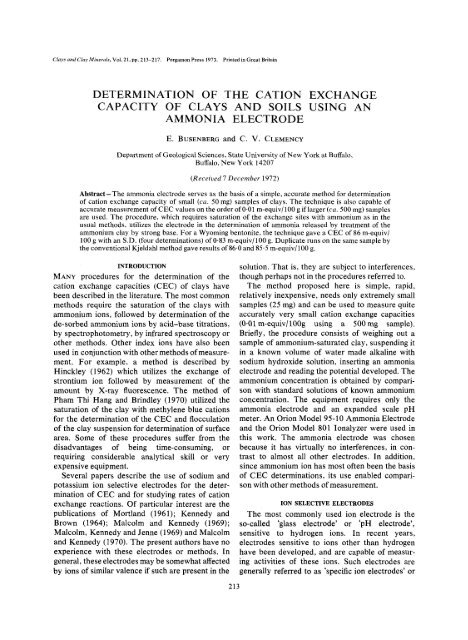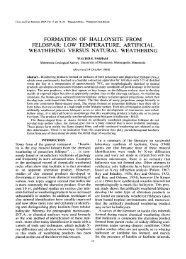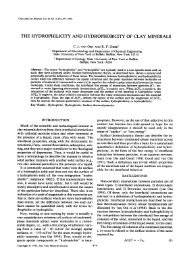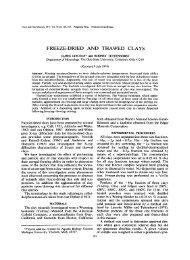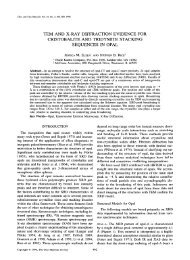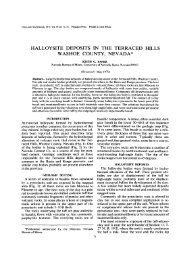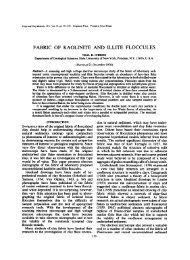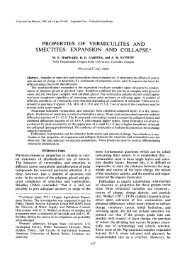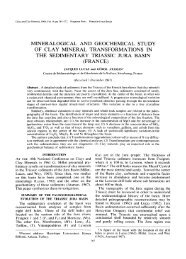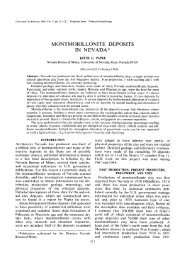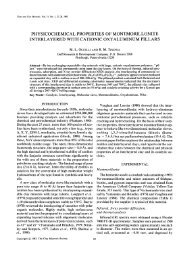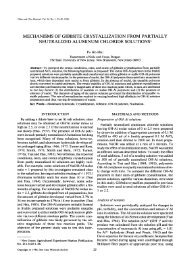Determination of cation exchange using ammonia - Clay Minerals ...
Determination of cation exchange using ammonia - Clay Minerals ...
Determination of cation exchange using ammonia - Clay Minerals ...
You also want an ePaper? Increase the reach of your titles
YUMPU automatically turns print PDFs into web optimized ePapers that Google loves.
<strong>Clay</strong>s and <strong>Clay</strong> <strong>Minerals</strong>, Vol. 21, pp. 213-217.<br />
Pergamon Press 1973. Printed in Great Britain<br />
DETERMINATION OF THE CATION<br />
CAPACITY OF CLAYS AND SOILS<br />
AMMONIA ELECTRODE<br />
EXCHANGE<br />
USING AN<br />
E. BUSENBERG and C. V. CLEMENCY<br />
Department <strong>of</strong> Geological Sciences, State University <strong>of</strong> New York at Buffalo,<br />
Buffalo, New York 14207<br />
(Received 7 December 1972)<br />
Abstract-The <strong>ammonia</strong> electrode serves as the basis <strong>of</strong> a simple, accurate method for determination<br />
<strong>of</strong> <strong>cation</strong> <strong>exchange</strong> capacity <strong>of</strong> small (ca. 50 nag) samples <strong>of</strong> clays. The technique is also capable <strong>of</strong><br />
accurate measurement <strong>of</strong> CEC values on the order <strong>of</strong> 0.01 m-equiv/100 g if larger (ca. 500 mg) samples<br />
are used. The procedure, which requires saturation <strong>of</strong> the <strong>exchange</strong> sites with ammonium as in the<br />
usual methods, utilizes the electrode in the determination <strong>of</strong> <strong>ammonia</strong> released by treatment <strong>of</strong> the<br />
ammonium clay by strong base. For a Wyoming bentonite, the technique gave a CEC <strong>of</strong> 86 m-equiv/<br />
100 g with an S.D. (four determinations) <strong>of</strong> 0.83 m-equiv/100 g. Duplicate runs on the same sample by<br />
the conventional Kjeldahl method gave results <strong>of</strong> 86.0 and 85-5 m-equiv/100 g.<br />
INTRODUCTION<br />
MANY procedures for the determination <strong>of</strong> the<br />
<strong>cation</strong> <strong>exchange</strong> capacities (CEC) <strong>of</strong> clays have<br />
been described in the literature. The most common<br />
methods require the saturation <strong>of</strong> the clays with<br />
ammonium ions, followed by determination <strong>of</strong> the<br />
de-sorbed ammonium ions by acid-base titrations,<br />
by spectrophotometry, by infrared spectroscopy or<br />
other methods. Other index ions have also been<br />
used in conjunction with other methods <strong>of</strong> measurement.<br />
For example, a method is described by<br />
Hinckley (1962) which utilizes the <strong>exchange</strong> <strong>of</strong><br />
strontium ion followed by measurement <strong>of</strong> the<br />
amount by X-ray fluorescence. The method <strong>of</strong><br />
Pham Thi Hang and Brindley (1970) utilized the<br />
saturation <strong>of</strong> the clay with methylene blue <strong>cation</strong>s<br />
for the determination <strong>of</strong> the CEC and flocculation<br />
<strong>of</strong> the clay suspension for determination <strong>of</strong> surface<br />
area. Some <strong>of</strong> these procedures suffer from the<br />
disadvantages <strong>of</strong> being time-consuming, or<br />
requiring considerable analytical skill or very<br />
expensive equipment.<br />
Several papers describe the use <strong>of</strong> sodium and<br />
potassium ion selective electrodes for the determination<br />
<strong>of</strong> CEC and for studying rates <strong>of</strong> <strong>cation</strong><br />
<strong>exchange</strong> reactions. Of particular interest are the<br />
publi<strong>cation</strong>s <strong>of</strong> Mortland (1961); Kennedy and<br />
Brown (1964); Malcolm and Kennedy (1969);<br />
Malcolm, Kennedy and Jenne (1969) and Malcolm<br />
and Kennedy (1970). The present authors have no<br />
experience with these electrodes or methods. In<br />
general, these electrodes may be somewhat affected<br />
by ions <strong>of</strong> similar valence if such are present in the<br />
solution. That is, they are subject to interferences,<br />
though perhaps not in the procedures referred to.<br />
The method proposed here is simple, rapid,<br />
relatively inexpensive, needs only extremely small<br />
Samples (25 mg) and can be used to measure quite<br />
accurately very small <strong>cation</strong> <strong>exchange</strong> capacities<br />
(0.01 m-equiv/100g <strong>using</strong> a 500 mg sample).<br />
Briefly, the procedure consists <strong>of</strong> weighing out a<br />
sample <strong>of</strong> ammonium-saturated clay, suspending it<br />
in a known volume <strong>of</strong> water made alkaline with<br />
sodium hydroxide solution, inserting an <strong>ammonia</strong><br />
electrode and reading the potential developed. The<br />
ammonium concentration is obtained by comparison<br />
with standard solutions <strong>of</strong> known ammonium<br />
concentration. The equipment requires only the<br />
<strong>ammonia</strong> electrode and an expanded scale pH<br />
meter. An Orion Model 95-10 Ammonia Electrode<br />
and the Orion Model 801 Ionalyzer were used in<br />
this work. The <strong>ammonia</strong> electrode was chosen<br />
because it has virtually no interferences, in contrast<br />
to almost all other electrodes. In addition,<br />
since ammonium ion has most <strong>of</strong>ten been the basis<br />
<strong>of</strong> CEC determinations, its use enabled comparison<br />
with other methods <strong>of</strong> measurement.<br />
ION SELECTIVE ELECTRODES<br />
The most commonly used ion electrode is the<br />
so-called 'glass electrode' or 'pH electrode',<br />
sensitive to hydrogen ions. In recent years,<br />
electrodes sensitive to ions other than hydrogen<br />
have been developed, and are capable <strong>of</strong> measuring<br />
activities <strong>of</strong> these ions. Such electrodes are<br />
generally referred to as 'specific ion electrodes' or<br />
213
214<br />
E. BUSENBERG and C. V. CLEMENCY<br />
'ion selective electrodes'. General discussions <strong>of</strong><br />
their principles and uses may be found in Durst<br />
(1969) and in Moody and Thomas (1971).<br />
Most ion selective electrodes respond directly to<br />
the activity <strong>of</strong> the desired ion in aqueous solution,<br />
but this response may be affected by the presence<br />
<strong>of</strong> other ionic species, especially those <strong>of</strong> Similar<br />
charge. The ability <strong>of</strong> the electrode to discriminate<br />
between the desired ion and others is a measure <strong>of</strong><br />
its efficiency and freedom from interferences.<br />
The <strong>ammonia</strong> electrode, which operates on a<br />
somewhat different principle, merits discussion.<br />
What follows is taken (with permission) largely<br />
from the Orion Instruction Manual (Anonymous,<br />
1972). The Orion <strong>ammonia</strong> electrode is a gas-detecting<br />
electrode, which is able to sense the level <strong>of</strong> dissolved<br />
<strong>ammonia</strong> (not ammonium) in aqueous solution.<br />
Nevertheless, it is used as if it were a specific<br />
ion electrode. The electrode can be used to measure<br />
ammonium by addition <strong>of</strong> strong base to convert<br />
ammonium to <strong>ammonia</strong> according to the<br />
equation: NH4 ++OH- -~ NH3+ HzO. Nitrate<br />
can he measured after reduction to <strong>ammonia</strong>, and<br />
organic nitrogen can be determined after Kjeldahl<br />
digestion <strong>of</strong> the sample and addition <strong>of</strong> strong base.<br />
The <strong>ammonia</strong> electrode is free <strong>of</strong> interferences by<br />
<strong>cation</strong>s, anions and other dissolved species,<br />
except volatile amines. Sample color and turbidity<br />
do not affect the measurement.<br />
Although the <strong>ammonia</strong> electrode is functionally<br />
simple, the mechanism <strong>of</strong> its operation is complex.<br />
Like other electrodes it follows Nernst's Law and<br />
responds logarithmically to the activity <strong>of</strong> dissolved<br />
<strong>ammonia</strong> in a solution. The activity is proportional<br />
to the <strong>ammonia</strong> concentration, which, in turn, is<br />
proportional to the concentration <strong>of</strong> ammonium<br />
ion that was originally present.<br />
The electrode contains a hydrophobic membrane<br />
which is permeable to <strong>ammonia</strong>, but not to any<br />
ionic species. Dissolved <strong>ammonia</strong> in the sample<br />
solution diffuses into the electrode until the<br />
activity <strong>of</strong> <strong>ammonia</strong> is the same on both sides <strong>of</strong> the<br />
membrane. Ammonia which passes through the<br />
membrane dissolves in solution contained within<br />
the electrode according to the equation:<br />
NH3+ H20 ~ NH4++ OH- (1)<br />
The potential <strong>of</strong> an internal sensing element varies<br />
in a Nernstian manner with changes in the hydroxide<br />
level:<br />
E = E0--S log [OH-] (2)<br />
where S is the slope <strong>of</strong> the electrode response:<br />
The relationship between <strong>ammonia</strong>, and ammonium<br />
and hydroxide ions is given by the equation:<br />
[NH4 +] [OH-] = constant. (3)<br />
[NH3]<br />
The internal filling solution contains ammonium<br />
chloride at a sufficiently high concentration so that<br />
[NH4 +] can be considered fixed. Equation (3)<br />
then becomes:<br />
[OH-] = [NH3] . constant' equations. (4)<br />
Combination <strong>of</strong> (2 and 4) shows that the electrode<br />
response to <strong>ammonia</strong> is also Nernstian.<br />
Each ten-fold increase in <strong>ammonia</strong> concentration<br />
gives rise to a minus 58.5 mV change in electrode<br />
potential at room temperature. The potential<br />
developed under standard conditions is reproducible<br />
to better than -+0.5mV, or -+2 per cent<br />
according to the Orion manual (Anonymous, 1972).<br />
The <strong>ammonia</strong> electrode can accurately measure<br />
concentrations as low as 10 parts per billion.<br />
Ordinary distilled water contains levels <strong>of</strong> <strong>ammonia</strong><br />
higher than this. It is also important, therefore, to<br />
use <strong>ammonia</strong>-free water in all experiments. This<br />
standard can easily be prepared by passing distilled<br />
water through a commercial ion-<strong>exchange</strong>r<br />
which reduces the concentration <strong>of</strong> <strong>ammonia</strong> to<br />
below the limit <strong>of</strong> detection <strong>of</strong> the electrode. Care<br />
must also be used to avoid storing or opening<br />
<strong>ammonia</strong> reagent bottles in the same room<br />
EXPERIMENTAL<br />
The ammonium saturated clays were prepared<br />
(Chapman, 1965) by allowing the starting sample<br />
to stand overnight in 1N ammonium acetate solution<br />
which had been adjusted to pH 7, after which<br />
the samples were leached with 1N NH4CI. Excess<br />
ammonium salts were removed by washing<br />
with isopropyl alcohol, after which the clays were<br />
dried and ready for determination <strong>of</strong> CEC. An<br />
alternate method designed for quantitative recovery<br />
<strong>of</strong> small samples has been described by Mackenzie<br />
(1951).<br />
For the measurement <strong>of</strong> the CEC, a 50-150 mg<br />
sample <strong>of</strong> air-dried, ammonium-saturated clay was<br />
weighed out and transferred to a 100ml Pyrex<br />
beaker containing a Teflon-covered stirring bar,<br />
89 in length. Exactly 50 ml <strong>of</strong> <strong>ammonia</strong>-free,<br />
deionized-distilled water were added. Stirring was<br />
commenced and maintained at a constant level (a<br />
necessary condition) while measuring both samples<br />
and standards. A small magnetic stirrer motor,<br />
connected to a Powerstat regulator set at a constant<br />
value, was used. Air-driven stirrers are not
<strong>Determination</strong> <strong>of</strong> <strong>cation</strong> <strong>exchange</strong> <strong>using</strong> <strong>ammonia</strong> electrode<br />
215<br />
recommended. The electrode was immersed in the<br />
suspension, taking care to prevent entrapment <strong>of</strong><br />
air bubbles under the concave tip. By means <strong>of</strong><br />
a syringe, 89 ml <strong>of</strong> 10 M sodium hydroxide solution<br />
was added to the beaker, and a timer was started.<br />
This amount <strong>of</strong> NaOH will quantitatively displace<br />
all accessible NH, + and convert it to NH3. Electrode<br />
readings were taken at 89 intervals until a<br />
constant potential was recorded for two or three<br />
readings. Two to five min were usually required<br />
before the electrode reached equilibrium. Longer<br />
times were required for lower <strong>ammonia</strong> concentrations.<br />
To determine the CEC <strong>of</strong> the clay sample,<br />
the unknown is compared to two standard solutions<br />
<strong>of</strong> ammonium chloride <strong>of</strong> concentrations which<br />
bracket the unknown concentration. Standards <strong>of</strong><br />
low concentration (< 10-SM) should be freshly<br />
prepared daily by dilution, with <strong>ammonia</strong>-free<br />
water, <strong>of</strong> a 0.1 M primary standard solution. Solutions<br />
<strong>of</strong> 10-* M are good for 1 week. The known<br />
solutions range from 10 -2 to 10 -5 M, with most<br />
clays falling within the 10-a-10 -4 M range.<br />
The concentration <strong>of</strong> <strong>ammonia</strong> released from the<br />
clay by the sodium hydroxide can be determined<br />
graphically (Fig. 1), or can be read directly from the<br />
previously calibrated scale <strong>of</strong> the ion-analyzer,<br />
which is simply a pH meter with an expansible<br />
scale. The ion-analyzer is calibrated by bracketing<br />
-I00<br />
-~-50<br />
o<br />
"i 5C<br />
IOC<br />
10 -5<br />
10 4 i0 -3 i0 -~<br />
Ammonio concentrotion, mo[es/ L.<br />
Fig. 1. Graph used to determine <strong>ammonia</strong> concentration<br />
from electrode potential. (Adapted with permission <strong>of</strong><br />
Orion Research Inc. from Instructional Manual for<br />
Ammonia Specific Ion Electrode, p. 6).<br />
the unknown with two standard ammonium chloride<br />
solutions, a procedure analogous to the standardization<br />
<strong>of</strong> a pH meter by <strong>using</strong> two buffer solutions<br />
<strong>of</strong> known pH.<br />
The CEC <strong>of</strong> the sample is obtained from the<br />
following equation:<br />
where<br />
CEC -- (c) (v) (5)<br />
(w) (f)<br />
CEC = the <strong>cation</strong> <strong>exchange</strong> capacity <strong>of</strong> the sample<br />
expressed in m-equiv per 100g <strong>of</strong> clay, and<br />
c = concentration <strong>of</strong> <strong>ammonia</strong> in moles per 1.<br />
v = volume <strong>of</strong> water added (50 ml in this case)<br />
w = weight <strong>of</strong> the sample in mg<br />
f = a conversion factor, in this case a constant<br />
equal to 10 -~.<br />
With careful technique, this method is capable<br />
<strong>of</strong> accurate measurement <strong>of</strong> <strong>exchange</strong> capacities<br />
as low as 0.01 m-equiv/100g with a sample <strong>of</strong> only<br />
500 rag. For higher <strong>exchange</strong> capacities, smaller<br />
samples are used. The manual for the <strong>ammonia</strong><br />
electrode (Anonymous, 1972) states that the<br />
reproducibility <strong>of</strong> the electrode under standard<br />
conditions is -+0"5mV or +--2 per cent <strong>of</strong> the<br />
concentration measured. In order to establish the<br />
precision obtainable on replicate samples <strong>using</strong> this<br />
method, four determinations <strong>of</strong> CEC were made on<br />
each <strong>of</strong> the following samples: kaolinite, S.C.;<br />
illite, Ill.; illitic soil, Ill; and montmorillonite, Wyo.<br />
The S.D. found for each material was 0.06, 0.25,<br />
0"75 and 0.83 m-equiv/100g, respectively.<br />
RESULTS AND DISCUSSION<br />
The CEC <strong>of</strong> 6 clays and 1 soil were determined<br />
by the procedure described in this paper and also<br />
by 4 other common methods <strong>of</strong> <strong>ammonia</strong> recovery.<br />
The other methods used were: the aeration method<br />
<strong>of</strong> Potter and Snyder as modified by Vanselow (in<br />
Chapman, 1965); Mackenzie's (1951) procedure,<br />
and by two variations <strong>of</strong> the Kjeldahl method. In<br />
the usual Kjeldahl digestion, the sample is boiled<br />
in 36N sulfuric acid for 1 hr, then 50 per cent<br />
NaOH is added until the solution is alkaline. The<br />
<strong>ammonia</strong> is then distilled <strong>of</strong>f and collected (in the<br />
variation <strong>of</strong> the method used for this study) in an<br />
excess <strong>of</strong> saturated boric acid solution. The boric<br />
acid fixes the <strong>ammonia</strong>. However, since boric acid<br />
is neutral to methyl red, use <strong>of</strong> this indicator permits<br />
direct titration <strong>of</strong> the <strong>ammonia</strong> with standardized<br />
HC1. The samples were run <strong>using</strong> this method.<br />
Then for comparison, the same Kjeldahl distillation<br />
procedure was used to separate the <strong>ammonia</strong>,<br />
but the <strong>ammonia</strong> was determined <strong>using</strong> the <strong>ammonia</strong><br />
electrode instead <strong>of</strong> by titration. With the other<br />
methods, the <strong>ammonia</strong> electrode was used to<br />
determine the <strong>ammonia</strong> concentration.
216 E. BUSENBERG and C. V. CLEMENCY<br />
Table 1. Comparison <strong>of</strong> results <strong>of</strong> <strong>cation</strong>-<strong>exchange</strong> capacity determinations on 5 clays, 1 clay<br />
soil and 1 macro-crystalline vermiculite which was ground to -200mesh. Numbers are<br />
expressed in m-equiv/100g <strong>of</strong> sample and are the average <strong>of</strong> 4 determinations, with the exception<br />
<strong>of</strong> the numbers in the last row, where lack <strong>of</strong> sample prevented multiple determinations.<br />
Those marked with an asterisk in the last row indicate a single determination, while those with<br />
two numbers were run in duplicate, the two numbers giving the individual results<br />
Method Kaol. Kaol. Mont. Mont. Illite Illitic Vermiculite<br />
S.C. Ga. Wyo. Miss. Ill. Soil Transvaal<br />
Ill. (ground to<br />
- 200 mesh)<br />
Ammonia 2.8 3.0 86 81 23 13<br />
electrode method<br />
(this paper)<br />
Mackenzie (1951) 2.7 3.3 86 81 23 13<br />
distillation method<br />
(<strong>using</strong> electrode)<br />
Aeration method 2.8 3.3 84 80 25 13<br />
(Chapman, 1965)<br />
(<strong>using</strong> electrode)<br />
Standard Kjeldahl 2.8 3.4 88 83 24 14<br />
digestion method<br />
(<strong>using</strong> electrode)<br />
Standard Kjeldahl 3.0* 3.3* 86.0, 80.0, 24* 13.3"<br />
digestion method 85-5 81.0<br />
(by titration)<br />
83<br />
85<br />
83<br />
88<br />
86"0<br />
86'0<br />
* Lack <strong>of</strong> sample prevented running multiple analyses<br />
The results obtained by the five methods are<br />
shown in Table 1. All methods are in good agreement<br />
for the two kaolinites, the two montmorillonites,<br />
the illite and the illitic soil. For the vermiculite,<br />
the Kjeldahl digestion gave slightly higher<br />
results than the other three methods. The discrepancy<br />
is though to be caused by fixation <strong>of</strong> <strong>ammonia</strong><br />
by the vermiculite, and only the Kjeldahl method,<br />
which completely destroys the clay structure,<br />
frees all the <strong>ammonia</strong>. The other methods thus<br />
give slightly lower results.<br />
CONCLUSIONS<br />
The obvious advantages <strong>of</strong> this method are<br />
simplicity, speed, accuracy, ability to utilize small<br />
sample sizes (50 rag) and freedom from interferences.<br />
CEC determinations can be made as easily as<br />
the determination <strong>of</strong> pH and almost as rapidly,<br />
once the <strong>ammonia</strong>-saturated clay has been prepared.<br />
The results compare extremely well with<br />
standard methods. Another attractive feature is<br />
the capability <strong>of</strong> accurate measurement <strong>of</strong> extremely<br />
small CEC, on the order <strong>of</strong> 0.01 m-equiv/100g<br />
if larger samples (500 mg) are used. The method<br />
should be easily adaptable for measurement <strong>of</strong><br />
ammonium present on clays and soils in the field,<br />
if a field procedure for drying and accurately<br />
weighing a sample can be found, since suitable<br />
portable pH meters are available.<br />
REFERENCES<br />
Anonymous (1972) Instructional Manual: Ammonia<br />
Electrode Model 95-10: Orion Research Inc., Cambridge,<br />
Mass. 24 pp.<br />
Chapman, H. D. (1965) Cation <strong>exchange</strong> capacity. In<br />
Methods <strong>of</strong> Soil Analysis (Edited by Black, C. A.)<br />
Part 2, pp. 891-901. Number 9 in the seriesAgronomy:<br />
Am. Inst. Agronomy, Madison, Wisconsin.<br />
Durst, R. A. (Editor) (1969) Ion Selective Electrodes:<br />
National Bureau <strong>of</strong> Standards Publi<strong>cation</strong> 314, 452<br />
pp. Superintendent <strong>of</strong> Documents, Washington, D.C,<br />
Hinckley, D. N. (1962) An X-ray spectrographic method<br />
for measuring base <strong>exchange</strong> capacity: Amer. Mineralogist<br />
47,993-996.<br />
Kennedy, V. C. and Brown, T. E. (1964) Experiments<br />
with a sodium-ion electrode as a means <strong>of</strong> studying<br />
<strong>cation</strong>-<strong>exchange</strong> rates. <strong>Clay</strong>s and <strong>Clay</strong> <strong>Minerals</strong>,<br />
13, 351-352.<br />
Mackenzie, R. C. (1951) A micromethod for the determination<br />
<strong>of</strong> <strong>cation</strong> <strong>exchange</strong> capacities <strong>of</strong> clays: J.<br />
Colloid Sci. 6, 219-222.<br />
Malcolm, R. L. and Kennedy, V, C. (1969) Rate <strong>of</strong> <strong>cation</strong><br />
<strong>exchange</strong> on clay minerals as determined by specific<br />
ion electrode techniques: Soil Sci. Soc. Am. Proc. 33<br />
(2), 247-253.<br />
Malcolm, R. L., Kennedy, V. C. and Jenne, E. A. (1969)<br />
<strong>Determination</strong> <strong>of</strong> <strong>cation</strong> <strong>exchange</strong> capacity with the<br />
potassium specific ion electrode: Int. <strong>Clay</strong> Conf. Proc.,<br />
Tokyo 1,573-583.<br />
Malcolm, R. L. and Kennedy, V. C. (1970) Variation <strong>of</strong>
<strong>cation</strong> <strong>exchange</strong> capacity and rate with particle size in<br />
stream sediment: J. Water Pollut. Control Fed., Part 2,<br />
R153-R160.<br />
Moody, G. J. and Thomas, J. D. R. (1971) Selective Ion<br />
Sensitive Electrodes: Merrow Publishing Co., London,<br />
140 pp.<br />
Mortland, M. M. (1961) Using a glass electrode for<br />
<strong>Determination</strong> <strong>of</strong> <strong>cation</strong> <strong>exchange</strong> <strong>using</strong> <strong>ammonia</strong> electrode<br />
217<br />
estimating <strong>exchange</strong>able potassium in soils: Michigan<br />
Agric. Experiment Station Quarterly Bull. 43 (3),<br />
491-498.<br />
Pham Thi Hang and Brindley, G. W. (1970) Methylene<br />
blue absorption by clay minerals. <strong>Determination</strong> <strong>of</strong><br />
surface areas and <strong>cation</strong> <strong>exchange</strong> capacities. <strong>Clay</strong>s<br />
and <strong>Clay</strong> <strong>Minerals</strong> 18,203-212.<br />
R~suml-L'61ectrode ~t <strong>ammonia</strong>que sert de base ~t une m6thode simple et pr6cise pour la d6termination<br />
de la capacit6 d'6change de petits 6chantillons d'argile (environ 50 mg). La technique permet<br />
6galement de mesurer avec pr6cision les valeurs de CEC de l'orde de 0,01 meq/100 g si des 6chantillons<br />
plus importants (environ 500 rag) sont utilis6s. Ce proc~d6, qui n~cessite la saturation des sites<br />
d'6change avec I'ammonium comme dans le cas des m6thodes habituelles, utilise l'61ectrode dans le<br />
but de doser I'<strong>ammonia</strong>que lib6r6e par l'argile ammonium lors d'un traitement par une base forte.<br />
Pour une bentonite du Wyoming, cette technique a donn6 une CEC de 86 m-equiv./100 g avec une<br />
d6viation standard (quatre dosages) de 0,83 m-equiv./100g. Des doubles effectu6s sur le m~me<br />
6chantillon par la methode Kjeldahl conventionnelle ont donn6 comme r6sultats 86,0 et 85,5 m-<br />
equiv./100 g.<br />
Kurzreferat-Die Ammoniumelektrode dient als Grundlage einer einfachen, genauen Methode zur<br />
Bestimmung der Kationenaustauschkapazitiit kleiner (ca 50 rag) Tonproben. Die gleiche Technik ist<br />
auch zur genauen Bestimmung yon Austauschkapazit~itswerten in der Gr6Benordnung von 0,01 reval/<br />
100 g geeignet, wenn gr6Bere Probenmengen (ca 500 mg) benutzt werden. Bei dem Verfahren, das<br />
eine Siittigung der Austauschpl~itze mit Ammoniumionen wie bei den iiblichen Methoden erfordert,<br />
wird die Elektrode zur Bestimmung des durch Behandlung des Ammonium-Tons mit starken Basen<br />
freigesetzten Ammoniums eingesetzt. Fiir einen Wyoming-Bentonit ergab die Methode eine Austauschkapazit<br />
t von 86 m-val/100 g mit einer Standardabweichung (4 Bestimmungen) von 0,83 m-<br />
val/100 g. Parallelbestimmungen an der gleichen Probe mit der konventionellen Kjeldahl-Methode<br />
ergaben 86,0 und 85,5 m-val/100 g.<br />
Pe3mMe -- AMMI~aqHbI~ 3neKTpoR cnyTK!~IT OCHOBam4eM npocToro ~I TO~moro MeToRa onpe~eaeaan<br />
CUOCO6HOCTH KaTHOHOO6MeHa He6onbmnx o6pa3uOB raHn~ (ca 50 Mr). ~TkIM cnoco6oM MO~HO<br />
Ta~>Ke a~xypaTHO Bb~MepSTb 3Ha~enHa CEC nop~;Iia 0,01 MeK/100 r, ecnl~ ncno~b3OBaTb 6oaee<br />
~pyrlnb~e o6pa3ttbi (ca 500 Mr). Hpotte~ypa, Tpe6yromaa nacblmennz aMMrlaKOM O6MeHHb~X y3noB<br />
KaK I/I IIO O6blqFIbIM MeTo~aM, npr~MeHfleT 3~eKTpOR ;~ onpeRe~enas B~JleaeHnoro aMMaara<br />
06pa6oT~Ofl aMMHaqHo~ rnHHbI l~pen~nM ocrtoBanrleM. ~TOT crIoc06 /Ia~ nai~oM~nrcKoro 6eTOu~Ta<br />
~aa CEC nops~x~a 86 Me~/100 r co cTan~lapTa~Mn OTKaoneansMa (~eT~rpe onpe~eaenna)<br />
0,83 MeK/100 r. ,~y6aupo~auuble onblxbI C 3T~M xe o6pa31lOM cTanlxapTa~,~M MeTOjIOM K~l~err~lana<br />
aann cnejlyromHe pe3yabTaTsI: 86,0 r~ 85,5 Mei/100 r.


